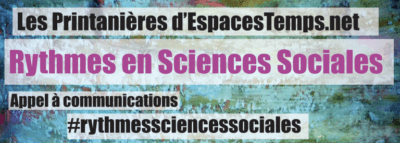BACKGROUND
In recent years, the question of rhythm has made a comeback in social science publications [acceleration (Rosa 2010), tyranny and the cult of urgency (Auber, 2009), burn out (Cœugnet and al., 2011) and time pressure (Szollos, 2009)]. The notion of rhythm is also used as a prism for interpreting urban temporalities (Amin andThrift, 2002), the relationship between the body and space (Edensor, 2012) and cultural differences (Levine, 1997).
In its common definition, rhythm refers to the idea of order and regularity. Considered as a regular, periodic, lilting movement, rhythm makes reference to a kind of back and forth as well as to regular intervals of an event, phenomenon or behavior in time. The conference’s aim is to show that rhythm is, in fact, a much richer, multi-faceted, complex, fluctuating concept (Michon, 2010) once we move away from the limited notion of rhythm movement. We might instead start from the term “rhuthmos”, which allows us to integrate irregular and spontaneous movements or other forms of time organization. Rhythm is a heuristic notion based on which we can analyze, observe, represent and also re-think “liquid society” (Bauman, 2013), “worlds” in “movement” (Drevon e tal., 2017), and their “paradoxes”(Kaufmann, 2008), a concept that allows us to go beyond the mobility turn (Urry, 2012) and create new interpretative frameworks for contemporary societies.
The concept of rhythm is also central to the critical approaches of postmodernity. Rhythm is mainly used as an indicator of acceleration. Hartmut Rosa, for example, condemns technical and social acceleration, which alienate individuals (Rosa, 2013). These forms of alienation refer, in particular, to the cult of urgency (Auber 2009), to multiple time pressures (Szollos, 2009) and more broadly, to saturation more generally (Citton, 2014). Beyond the miscegenation of times (career vs. family life) and the increasing importance of certain activity-related time budgets such as leisure (Viard, 2002), researchers have observed a densification of life rhythms that is amplified by multiple professional and domestic obligations to change spaces and roles (Kaufmann 2008). From a theoretical standpoint, an approach based on rhythms would allow us to take a fresh look at lifestyle, whose definition in terms of classic typologies (consumption, mobility, aspirations) is becoming increasingly blurred. Rhythmic approaches would reveal the temporal features of societies as well as identify their harmonies and dissonances and implications on individuals and collectives. Rhythm is also be revelatory of controversy. In response to the acceleration of the rhythms of life, initiatives from the “slow” movement (Heile and Knox, 2006) are becoming increasingly prominent. Such initiatives propose slowing down the pace by taking things more slowly, gaps and vacancy. “Urban” rhythms also appear to be grabbing the attention of these initiatives, given thatthey advocate for a slowdown and and a call for calm, especially in public spaces.
These initiatives form the basis for discussions about this call for calm and the making of new temporal commons (Gwiazdzinski, 2016) based on a return to slowness (Sansot, 1998). The controversies that arise through such antagonistic movements attest to the political nature of the issues raised by the notion of rhythm, which allows us to imagine new ways to strengthen time preferential public policies and the advancement of chrono-development (Gwiazdzinski, 2014, 2018). In the social sciences, the notion of rhythm raises a central question regarding the composition of life in society, in a “liquid world” (Bauman, 2013) marked by the individualization and cohabitation of lifestyles. The conference will aim to prove that the use of rhythm in social sciences based on a broad understanding of this concept is heuristic. The definition of rhythm both sensitive and experiential dimensions, as well as the critical dimension of the time-space prism of “Time Geography” (Hägerstraand, 1970),daily time-budgets, “time policy” experiments (Mallet, 2013) and “chronopolitical” or even “temporary and temporal urbanism” (Pradel, 2012;Gwiazdzinski, 2007).Rhythm opens us to the experience of “corporeality” and existence in Henry Maldiney’s sense. It helps to shed light on the dynamics of relationships between individuals, spaces and societies, offering an original perspective on issues of emancipation and domination. It also highlights the tension between “repetition” (Deleuze, 1972) and “innovation”- in our lives and in our cities, and the need for stability and disturbance. Rhythm materializes and unifies the field of mobility analysis by allowing us to reconcile the definition of mobility as the crossing of geographic space with that of mobility as change over time (Kaufmann, 2014).
ABSTRACT SUBMISSION AND GUIDELINES
The statement proposals should address the use of the notion of rhythm in the fields of Sociology, Geography, Political Science, Economics and Psychology. The proposals are in theoretical, methodological and artistic order. Critical approaches and controversies are notably expected to enrich the debate. The statements may take several forms:
- A summary (5000 characters max.)
- An image accompanied by a text explaining the thinking behind the proposal
- A 3-minutes video
- A proposal for a choreographic or artistic performance
- Music accompanied by a text that explains the approach
The presentations will be organized in the form of discussion sessions by theme group. Each speaker will be required to briefly present her or his ideas in the way she or he deems most appropriate.
PUBLICATION
A selection of contributions will be published in the journal espacestemps.net after peer-review.
Communication proposals
All communication proposals should be sent to guillaume.drevon@epfl.ch before March 22, 2019. The proposals will be evaluated by the espacestemps.net scientific committee. The authors will be informed of the committee’s decision by April 2, 2019. The conference will take place on May 9-10, 2019 at EPFL
COMMITTEES
Scientific coordination
- Guillaume Drevon (Geography)
Organization committee
- Boris Beaude (Culture, society, digital humanities)
- Ceyda Bakbasa Bosson (Urban studies)
- Garance Clément (Sociologie)
- Gaël Chareyron (Computing science)
- Jean-Nicolas Fauchille (Planning)
- Christian Grataloup (Geography)
- Luc Gwiazdzinski (Geography)
- Marc Dumont (Geography)
- Vincent Kaufmann (Sociology)
- Jacques Lévy (Geography)
- Igor Moullier (Modern history)
- Patrick Poncet (Geography)
- Florence Graezer Bideau (Anthropology)
- Emmanuel Ravalet (Urban studies)
Contact : guillaume.drevon@epfl.ch

